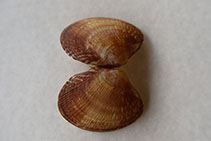Ruditapes philippinarum (Adams & Reeve, 1850)
Japanese carpet shell
Classification / Names Common names | Synonyms | CoL | ITIS | WoRMS
Bivalvia | Venerida | Veneridae
Environment: milieu / climate zone / depth range / distribution range Ecology
Benthic; brackish; pH range: 13.5 - 35.0; depth range 0 - 100 m (Ref. 356). Tropical; ? - 35°C (Ref. 104360), preferred 18°C (Ref. 107945); 56°N - 11°S, 75°E - 164°E (Ref. 348)
Distribution Countries | FAO areas | Ecosystems | Occurrences | Introductions
Indo-Pacific and the Mediterranean: from India and Sri Lanka to Micronesia; north to Sakhalin, the Japan Sea and Hawaii (introduced), and south to Indonesia. Introduced in the Northeast Atlantic.
Length at first maturity / Size / Weight / Age
Maturity: Lm 2.7 range ? - ? cm Max length : 8.0 cm SHL male/unsexed; (Ref. 348); common length : 5.0 cm SHL male/unsexed; (Ref. 348); max. reported age: 14 years (Ref. 104360)
Life cycle and mating behavior Maturity | Reproduction | Spawning | Eggs | Fecundity | Larvae
Main reference
References | Coordinator | Collaborators
SAUP Database 2006 SAUP Database. www.seaaroundus.org. (Ref. 356)
IUCN Red List Status
(Ref. 130435: Version 2025-1)
CITES status (Ref. 108899)
CMS (Ref. 116361)
Threat to humans
Human uses
Fisheries: commercial
FAO - Aquaculture: production, species profile; Fisheries: landings, species profile | FishSource | Sea Around Us
Tools
More information
Max. ages / sizes
Length-weight rel.
Length-length rel.
Length-frequencies
Mass conversion
Abundance
Internet sources
BHL | BOLD Systems | CISTI | DiscoverLife | FAO(Aquaculture: species profile; Fisheries: species profile; publication : search) | Fishipedia | GenBank (genome, nucleotide) | GloBI | Gomexsi | Google Books | Google Scholar | Google | PubMed | Tree of Life | Wikipedia (Go, Search) | Zoological Record



